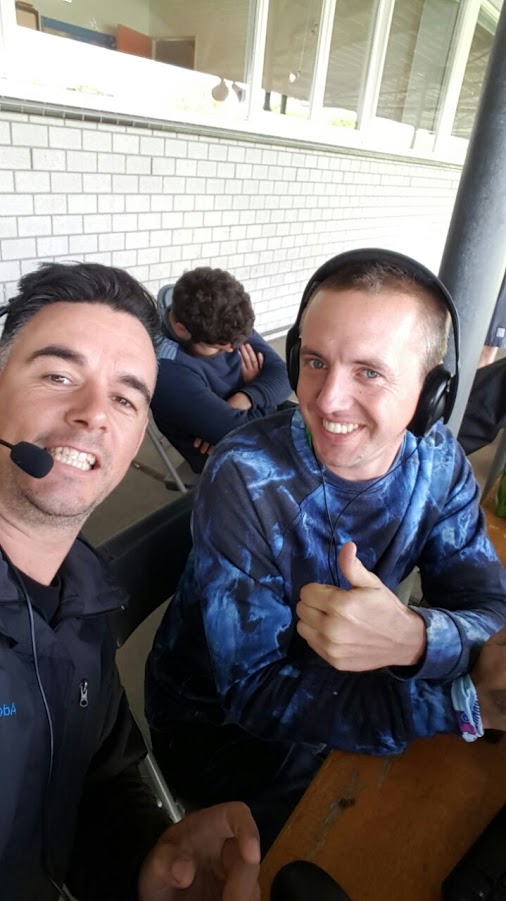Behind the Stream: Fanseat at Windmill 2017
Last weekend I was at Windmill for the first time ever! Instead of playing, I was part of the production crew putting together the live stream which went out on fanseat.com (and is currently available to view in their archives).
Who are Fanseat?
On the ground at Windmill, the production team was: Mike Palmer, Will Foster, Felix Shardlow, Anthony Wilson, Ari Ojanperä, Edgars Dimpers, and Callum Ayre. This team changes from event to event, but are currently always led by Mike Palmer or Will Foster. Nobody physically at these events is ‘from’ Fanseat – we communicate with them via messaging apps during the events to ensure everything is coming through to their end correctly.
 Other than Ant’s friend Callum, we are all avid Ultimate players who have also been involved in Ultimate media production – all except Edgars were active members of the WFDF Media Team providing coverage of WUGC 2016, all except Ari and Mike have worked for Push Pass previously, all except Edgars and Ari are involved with providing coverage of UK events for UK Ultimate, and Mike has been the primary provider of coverage in the southern hemisphere for many years through his company Ulti.TV and UltiSports (and was leading our team at Windmill).
Other than Ant’s friend Callum, we are all avid Ultimate players who have also been involved in Ultimate media production – all except Edgars were active members of the WFDF Media Team providing coverage of WUGC 2016, all except Ari and Mike have worked for Push Pass previously, all except Edgars and Ari are involved with providing coverage of UK events for UK Ultimate, and Mike has been the primary provider of coverage in the southern hemisphere for many years through his company Ulti.TV and UltiSports (and was leading our team at Windmill).
We worked together with the awesome commentary team to provide Fanseat with a high quality, fully-packaged live stream, which they then distribute to their subscribers. The commentary team included Benjamin Rees, Lorcan Murray, Georgina Morrison, Liam Grant, David Pryce, Ravi Vasudevan, and many others who all did a fantastic job in contributing to the coverage, adding knowledge, character, and emotion to make the matches really enjoyable to watch.
What does setting up for a 3-camera live stream entail?
We arrived at the venue a couple of days before the event to begin work. The place was already swarming with volunteers and Windmill crew, who were all great fun, and really friendly and helpful whenever we needed anything. Readying the cameras alone took hours – each camera requires the setup of all kinds of equipment and the use of much technical wizardry, all of which Mike Palmer has great experience with, in order to get the rig working together smoothly and allow the camera operators to do the best job possible. Once the setup is all tested in close quarters, the power/signal/data cables must be laid out stretching to either end zone, using cable covers at any points where players may be crossing. During the women’s final, apparently the Poland Mixed coach tried to move one of our power cables to make room for his team’s warmup, causing it to unplug, resulting in a complete power outage – nightmare! To get a solid internet connection to the switching desk when it was placed in the centre of the field, we used some beaming technology I didn’t even know existed to get the signal over from the clubhouse.
At the desk we have the main switching computer with control pad, plus a replay machine with a second monitor. If possible, we also set up a screen for the commentators so they can see the replays as they are broadcast, and have a better perspective on the play that just occurred – also helping them to stay connected with the viewers. As with everything technical, things rarely work immediately after first setup, so many hours was spent troubleshooting and even going into town to buy extra equipment – thankfully the experience Mike Palmer and the rest of the crew have meant that there were usually two potential solutions to any problem, which were weighed up and decided between, and we got everything working the night before the first games began.
What roles need to be filled during a stream?
Aside from the excellent job the commentators do, there are three basic roles for the production team during a live stream:
1) Switcher / Director / Visual Mixer – they sit at a computer which displays all the live shots from the three cameras, plus the current live output. Their job is to switch between the camera angles and coordinate the coverage – staying in constant communication with the camera operators to let them know who is currently live (everyone is hooked up with voice comms), what shots they want lined up, which camera will be live next, if there’s anything interesting worth replaying which may have been missed (for example, if the commentators are talking about a particular play), and to give the word to roll the replays when they are ready. They are also responsible for ensuring the commentators & game audio levels are well balanced.
2) Replay mixer – their role is to queue up replays of appropriate action from the best angles and let the director know they are ready to roll, as quickly as possible. It’s the directors call as to whether there is enough time during a stoppage to run the replay – always a tough decision during a stoppage or turnover – and the director should keep an eye on the game so the replay mixer can adjust the speed of the replay accordingly (they have a machine which has a slider controlling the speed). The replay mixer also exports the clips between points for later use, and chooses ones to consider for post-game highlight reels.
3) Camera operators – at Windmill we had camera 1 (middle-sideline) capturing an overview of the game whilst camera 2 and 3 (back of endzones) stayed tight to the action around the disc for replays. Attention must always be paid to the tracking the disc, removing ‘dead space’ from the frame, staying in focus, listening to the director’s instructions, and communicating back with any relevant information (such as a particularly good shot the director may not be seeing, or heads-up of a missed shot for the replay mixer). During stoppages, camera operators zoom in on the players who are discussing the call, to give viewers the best idea of what is going on. After scores, they capture the celebrations with the best framing and tracking possible – get those faces! We also coined the phrase “ShameCam” – when an operator would track a player who e.g. mac’d their D instead of catching it, resulting in a score – cue comms of “cam2 find the defender for ShameCam please… switching to cam2… cam2 you’re live – shame! shame! ok, switching to cam3…” over our comms – keeps us amused. Between points, there is an opportunity to get ‘colour’ shots – of the crowd, of flags in the venue, an overview of the fields outside the stadium, birds perching on aerials – to add context, variety, and atmosphere to the coverage, without missing the pull!
During the course of the tournament we changed up who was filling each of the roles, so we were able to understand what each role required, and thus work together better as a team. As we found our routine during a game, the camera operators would naturally line up the shots the director wanted, and we could relax into the ‘flow’ – chatting about the current action over the voice comms and having some banter (working through every game, every day, gets tiresome without some chat!). Releasing the production crew’s comms as an alternative commentary track would be the source of much hilarity.
 When a mistake is made on the stream, and you know that double-tapping a button, queuing up the wrong replay, or accidentally knocking the camera has just made thousands of people go “huh?” – breaking their concentration on the game – it can get stressful, so it’s important to stay positive and supportive over the voice comms. In a live streaming environment, nobody has the luxury of being able to take a break mid-game. When things go right, and you feel like an excellent game of Ultimate has been done justice by the stream you’ve provided, a strong post-game euphoria kicks in!
When a mistake is made on the stream, and you know that double-tapping a button, queuing up the wrong replay, or accidentally knocking the camera has just made thousands of people go “huh?” – breaking their concentration on the game – it can get stressful, so it’s important to stay positive and supportive over the voice comms. In a live streaming environment, nobody has the luxury of being able to take a break mid-game. When things go right, and you feel like an excellent game of Ultimate has been done justice by the stream you’ve provided, a strong post-game euphoria kicks in!
On a few occasions I actually got up and danced after finishing the stream as director. The work isn’t over after the last game though – cameras need to be brought in, the clips on the computer need to be exported and then edited into daily highlight videos, and everything packed away ready to be unpacked, set up and tested before the first game of the next day starts – some days are very long for the production crew (0730 – 0030 when making daily highlights), and the concentration needed is full-on and relentless. We do all love watching Ultimate though, so we’re motivated by trying to do the games in front of us justice – capturing memorable moments on camera, and conveying the atmosphere within the stands to all the viewers at home.
Will there be more events streamed?
I’m hoping to stay involved in future crews which are brought together to cover European Ultimate events – when I’m not playing. Fanseat are covering a ton of tournaments over the next few months – next up is WCBU, where they’ll be streaming from two pitches each day! Beyond that there’s EYUC, EMUC, EUCF, UKU Tours 2 & 3, and UKU Nationals, just for a start.
The first month’s subscription is free and gets you access to their archive, which includes many tournaments including Tom’s Tourney 2017, and EUCF 2016 – after that it’s £8 per month, which I think is reasonable. I didn’t intend this article to be an advert for Fanseat; hopefully now you understand more about who the Fanseat crew are on the ground, and that by supporting them you are supporting coverage of Ultimate by the players, for the players – so you can make a more informed decision at least.

Was a pleasure to be directing the stream whilst these players I coached during their time at Sussex / Brighton Universities won the final with Clapham
If you watched the streams and have any feedback – positive or otherwise – we’re always keen to hear it, so drop me a message. I know if I was a viewer, I would want a live online chat room alongside the livestream – this isn’t a feature on the Fanseat page, but perhaps the Ultimate Discord #livestream channel could be used and promoted by the commentators in future. Hope you enjoy/d the coverage and I hope to be a part of bringing more to you in the future!


























